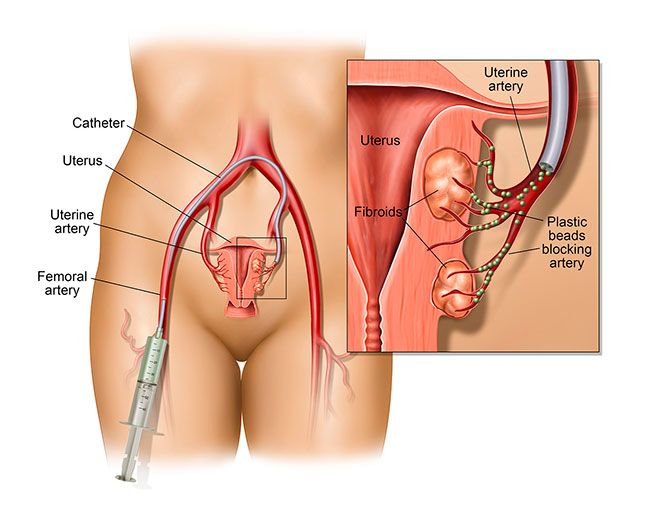Interventional Procedure
Uterine Fibroid Embolization
Introduction
Fibroid tumors are noncancerous (benign) growths that develop in the muscular wall of the uterus. While fibroids do not always cause symptoms, their size and location can lead to problems for some women, including pain and heavy bleeding. Fibroids can range in size from very tiny to the size of small fruit. In some cases, they can cause the uterus to grow to the size of a five-month pregnancy or more.
Symptoms & Diagnosis
Many women who have fibroids don’t have any symptoms. In those that do, symptoms can be influenced by the location, size, and number of fibroids.
In women who have symptoms, the most common signs and symptoms of uterine fibroids include:
- Heavy menstrual bleeding
- Menstrual periods lasting more than a week
- Pelvic pressure or pain
- Frequent urination
- Difficulty emptying the bladder
- Constipation
- Backache or leg pains
Treatment
Traditional surgical procedures
Options for traditional surgical procedures include:
Abdominal myomectomy. If you have multiple fibroids, very large fibroids or very deep fibroids, your doctor may use an open abdominal surgical procedure to remove the fibroids.
Many women who are told that hysterectomy is their only option can have an abdominal myomectomy instead. However, scarring after surgery can affect future fertility.
Hysterectomy. This surgery removes the uterus. It remains the only proven permanent solution for uterine fibroids.
Hysterectomy ends your ability to bear children. If you also elect to have your ovaries removed, the surgery brings on menopause and the question of whether you’ll take hormone replacement therapy. Most women with uterine fibroids may be able to choose to keep their ovaries.
Alternatives to Surgical Treatment & Hystrectomy
Women suffering from painful uterine fibroids — the most common cause of hysterectomies — now have an alternative, fibroid embolization, which can save them from having the surgical procedure. Interventional radiologists at The Johns Hopkins Hospital perform the fibroid embolization procedure, which involves cutting off blood flow to the fibroid, causing it to shrink.
What is Uterine Fibroid Embolization (UFE) ?

Fibroid embolization, also called uterine artery embolization, is done without surgery. It requires only a tiny nick in the skin about the size of a pencil tip. It is performed while the patient is conscious but sedated — drowsy and feeling no pain. Fibroid embolization is performed by an interventional radiologist, a physician who is specially trained to perform this and other minimally invasive procedures.
The interventional radiologist makes a small nick in the skin in the groin, through which a tiny tube called a catheter is inserted into an artery. The catheter is guided through the artery to the uterus while the interventional radiologist watches the progress of the procedure using a moving X-ray (fluoroscopy). When the catheter is in place, the interventional radiologist injects tiny plastic or gelatin sponge particles the size of grains of sand into the artery that supplies blood to the fibroid tumor. The particles cut off the blood flow to the fibroid and cause it to shrink.
Conclusion
Recovery time for patients undergoing transcatheter embolotherapy for fibroids is approximately one week. Vaginal spotting and discharge may occur for several weeks after completion of the procedure. We do not yet know the potential long-term impact of uterine artery embolization on fertility. Case reports have appeared in the medical literature of women who have become pregnant after uterine artery embolization for fibroids.
Please consult your doctor if you have the symptoms & signs associated with Fibroids for him to decide on the best possible treatment procedure for Fibroids

